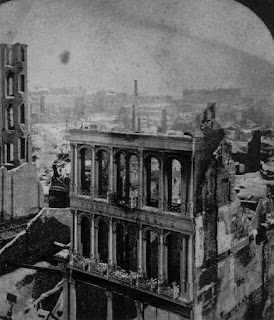 |
| Downtown Boston After The 1872 Fire |
That’s the headline that appeared on a newspaper article in “The Chelsea Public” in November 1872.
Today, the city of Chelsea, Massachusetts is an urban suburb of Boston, a short ride across the Mystic River and on the north side of Logan Airport. It’s the smallest city in Massachusetts when measured in land area and was a substantial community in its own right when the Great Boston Fire of November 1872 took place.
The Great Boston Fire was a national urban event in its time, second only in scope and in magnitude to the disastrous Chicago fire that had occurred in October of the previous year.
For most family historians who are tracing a Chelsea family, the Boston Fire of 1872 would be not much more than a historical blip that took place in a neighboring urban area, and would likely be completely overshadowed by the great Chelsea Fire that took place a year later in 1873.
However, a quick look at “The Chelsea Public” – specifically the edition of Saturday, November 16, 1872 – may suggest that the great Boston fire may have had a much greater effect on Chelsea than would at first be readily apparent.
That’s the beauty of newspaper research – you never know what you’re going to find until you actually look.
So, let’s look at the story that appeared on page one of “The Chelsea Public”, specifically Volume I, Number 31, that described the fire.
The subtitle of the article – “Chelsea’s Citizens who have Suffered in the Disaster, and their Losses.” - focuses the reader’s attention on the fact that the rest of story will be “local” to Chelsea. In other words, it won’t simply about the fire, but rather, about how the fire specifically affected Chelsea residents.
Here are some of the paragraphs that provide the local Chelsea twist.
“From the time that the first light of the fire was seen in Chelsea, until the close of Sunday, Chelsea was in a constant state of excitement. Winnisimmet street was thronged with people on their way to Boston. The Winnisimmet Ferry Co. never before carried so many persons across the water as they did on Sunday. About 1 o’clock on Sunday morning, teams began to cross for the purpose of carrying goods from the threatened neighborhoods, and a continuous line was hurriedly on the move throughout the day. Parties began to return from the scene of excitement on Sunday morning. Here and there could be seen individuals with a pile of books, the only thing saved from destruction.”
So, now we know that, in 1872, people still traveled between Chelsea and Boston by ferry, not by bridge. Moreover, we learn that people of Chelsea had a great interest in the destruction caused by the fire. Why was that? Consider the following:
“The immense paper warehouse of Dillingham & Co., a firm composed of Chelsea men, on Congress street, was consumed with about fifty thousand dollars worth of stock at most, and was insured for thirty thousand dollars, all good. They still have their old store on the corner of Merchants’ Row and South Market street left them, and will continue business at that place.”
Turns out, it wasn’t just Dillingham & Co. that had a Chelsea connection. There’s more:
“The Commission House of Aborn, Fay & Co., at the corner of Kilby and Central streets was during the night a rendezvous for some eight or ten Chelsea young men who were actively engaged wherever they could be of use in assisting friends in saving their goods. Among these may be mentioned Peleg Aborn, A.J. Clement, Henry P. Bailey, H.E. Streeter, W.E. Gilman, Frank Clement, William G. Reed, Edward Willcomb, and B.F. Dodge together with several Boston friends. Some of the finer qualities of Aborn, Fay & Co.’s goods were packed ready for moving early in the night when it was hardly expected the fire would advance so far in that direction, but at about four o’clock Sunday morning the fire had approached so near as to warrant the utmost despatch in conveying them to a place of safety, a team was engaged and a wagon-load was taken to and stored in the premises of Charles Kimball on commercial street.”
The article continues on in great detail about the variety of Chelsea connections to the great Boston fire of 1872. Many more names are mentioned, including a complete “Fire Directory” of the 24 businesses “…in which Chelsea men were interested…”
For today’s family historians, the message should be crystal-clear: think and research broadly. Don’t confine your research to the most obvious geographic area; be sure to look at the neighboring areas as well. Important local events often have regional implications.
Frankly, in 1872, your ancestors weren't sitting home in front of their computers, watching events unfold on the internet, and keeping track of things on Twitter and Facebook
Remember: in 1872, newspapers were where things were at, and the newspaper sources that can help you find information about the families you’re researching may be a town or two away.

What serendipity. I just recently read a copy of a Boston newspaper describing how a person in my family tree lost their publishing business in this fire in 1872. It devastated the downtown area. Of course, Chelsea suffered several conflagrations, too, over the years. This is a view of the fire that gives a new twist to the story.
ReplyDelete